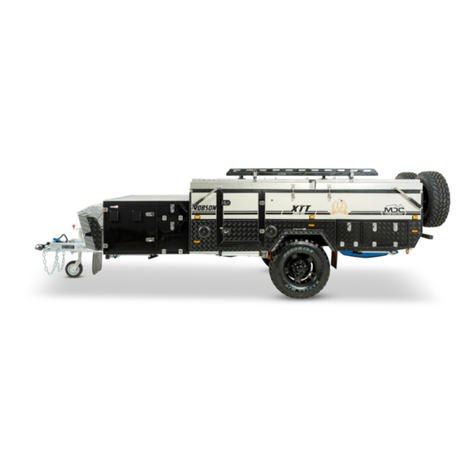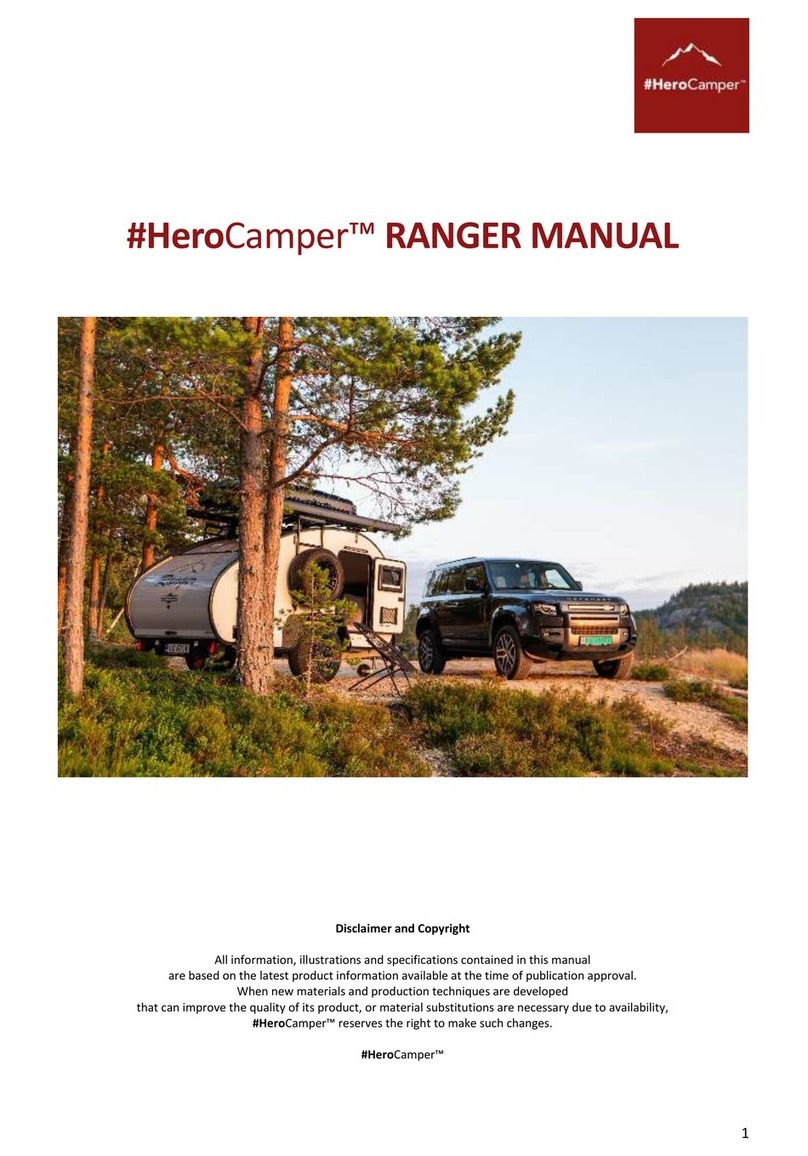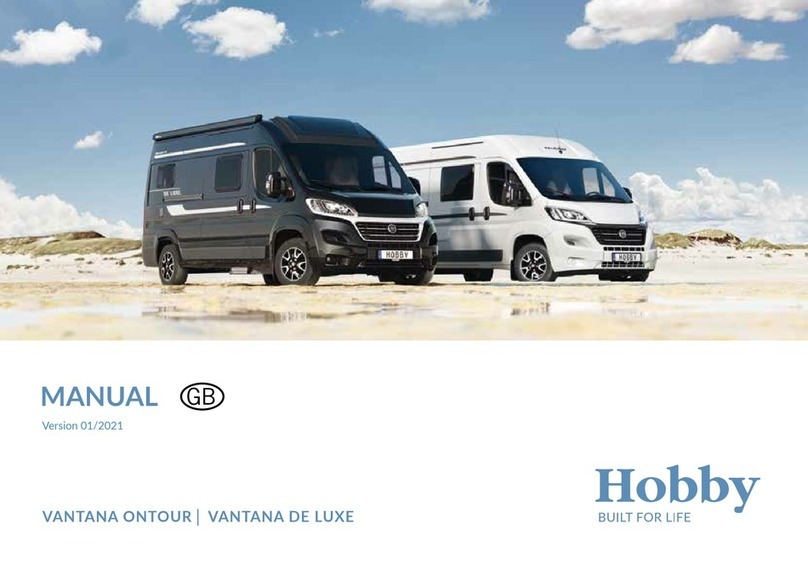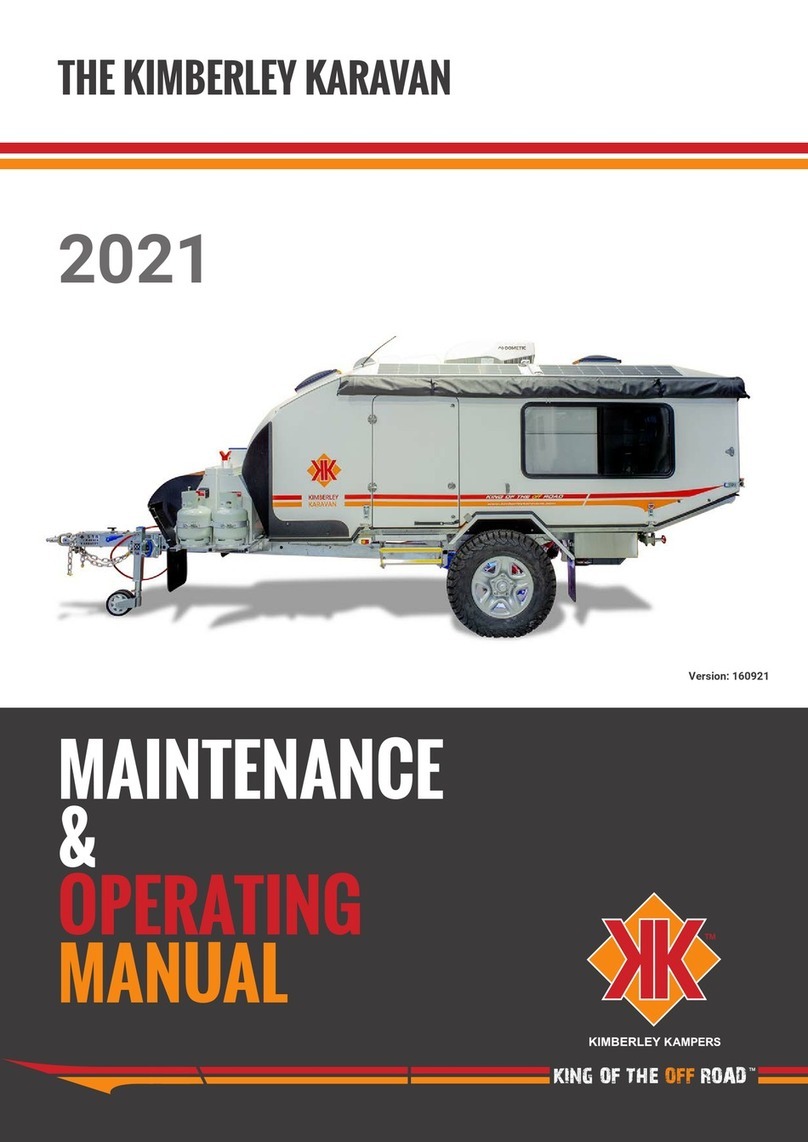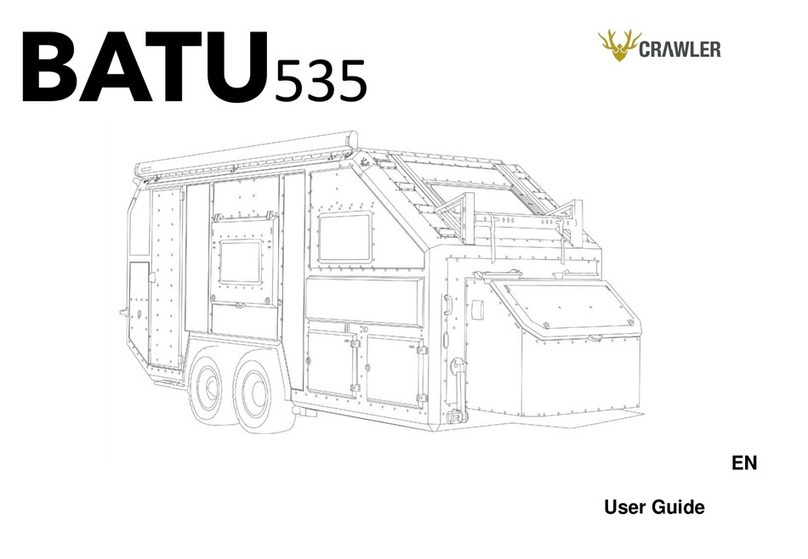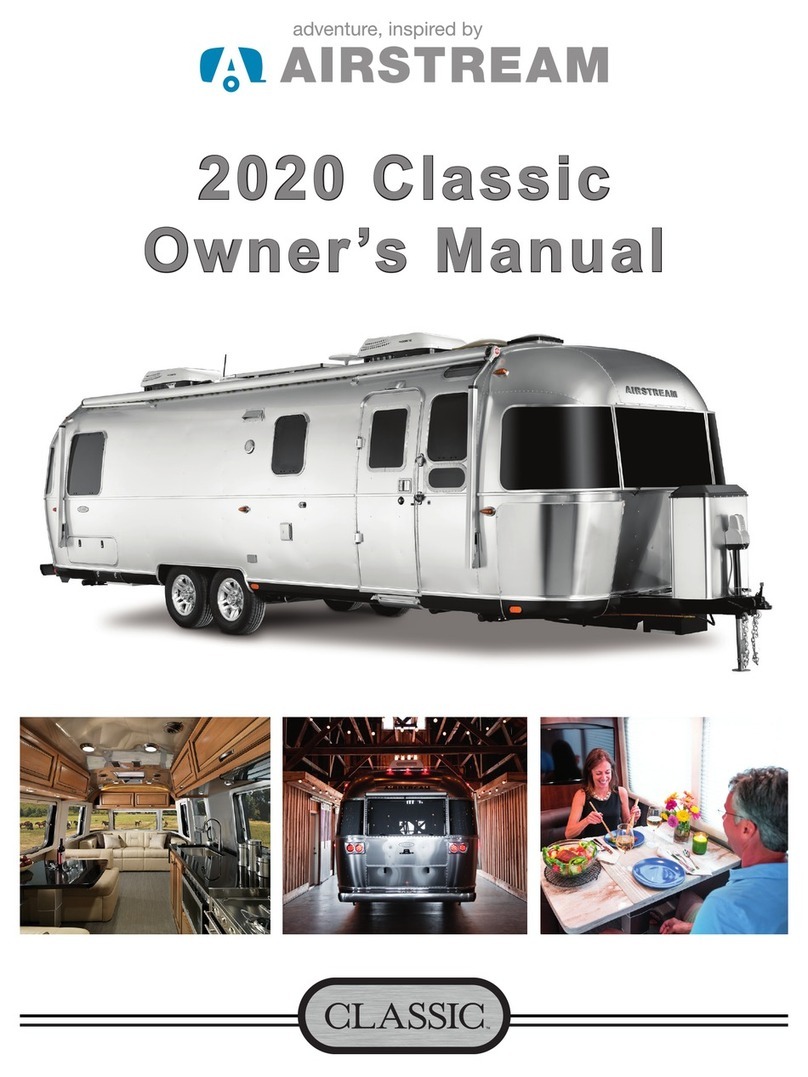EuroCaravaning VANTourer 2021 User manual

MANUAL
www.vantourer.de
From model year 2021

PLEASE NOTE
109-0006-08EN - 21/09
2
NOTE!
)Our motorhomes/caravans are always undergoing further development. We reserve the right to make
changes to the equipment, design and engineering without notice. This Operating Manual is only valid
in so far as the motorhome/caravan corresponds to the technology and specications described within.
For this reason, the EuroCaravaning GmbH & CO KG cannot accept any claims made on the basis of this
operating manual.
)The EuroCaravaning GmbH & CO KG accepts no liability for damages to the motorhome/caravan re-
sulting from failure to observe this operating manual.
)In addition to this Operating Manual, the generally applicable national and local safety regulations and
statutory provisions for the use of motorhomes/caravans must be observed.
)This Operating Manual describes the latest version of the motorhome/caravan when going to print.
)Reproduction, copying and translation (including extracts) are not permitted without the express per-
mission of the EuroCaravaning GmbH & CO KG.
EXPLANATION OF THE EQUIPMENT:
The equipment (factory-tted standard equipment and optional accessories/accessories) in our motorhomes/
caravans varies from model to model.
For this reason the features of the standard equipment as well as the features of the optional accessories/
extras are described in this Operating Manual as far as an explanation is necessary.
The instructions and information given in the operating manuals provided by the respective manufacturers
must be observed in addition.
My local VANTourer service centre
Address/stamp of the local VANTourer service centre
EuroCaravaning GmbH & CO KG
Im Metternicher Feld 5-7
D-56072 Koblenz
© 2021 KNAUS TABBERT AG, Jandelsbrunn
Date of issue: 21 September 2021

3
TABLE OF CONTENTS
109-0006-08EN - 21/09
Table of contents
1. Foreword .................................................................................. 10
1.1 Introduction .......................................................................................10
1.2 Vehicle data .......................................................................................11
1.3 Rating plate .......................................................................................11
2. Safety instructions ......................................................................... 12
2.1 List/explanation of utilised safety markings .........................................................12
2.2 Safety devices .....................................................................................12
2.3 Safety regulations for participation in road trac ...................................................13
2.4 General safety instructions .........................................................................14
2.5 Safety instructions for tting rear carrier systems....................................................15
2.6 Safety regulations for towing.......................................................................15
2.7 Safety instructions for the gas system. . . . . . . . . . . . . . . . . . . . . . . . . . . . . . . . . . . . . . . . . . . . . . . . . . . . . . . . . . . . . . . 15
2.8 Safety instructions for the electrical system .........................................................17
2.8.1 Starter and living area battery ......................................................................17
2.8.2 Emergency power generator .......................................................................18
2.9 Fire safety .........................................................................................18
2.9.1 Prevention of re hazards ..........................................................................18
2.9.2 Fire ghting .......................................................................................18
2.9.3 In case of re ......................................................................................19
2.10 Important notes for the sanitary area ...............................................................19
2.11 Important note for the kitchen range...............................................................19
2.12 Environmental notes...............................................................................20
2.13 Supplementary notes ..............................................................................20
2.14 Safety instructions for using the beds...............................................................21
2.15 Disposal of the vehicle .............................................................................21
3. Description & equipment ................................................................... 22
3.1 Base vehicle .......................................................................................22
3.2 Gas locker .........................................................................................22
3.3 Interior ttings and furniture .......................................................................22
3.4 Beds...............................................................................................22
3.5 Kitchen range. . . . . . . . . . . . . . . . . . . . . . . . . . . . . . . . . . . . . . . . . . . . . . . . . . . . . . . . . . . . . . . . . . . . . . . . . . . . . . . . . . . . . . 23
3.6 Seating layout .....................................................................................23
3.7 Heating and hot water .............................................................................23
3.8 Sanitary equipment................................................................................23
3.9 Fresh water and waste water .......................................................................23

4
TABLE OF CONTENTS
109-0006-08EN - 21/09
4. Before setting o........................................................................... 24
4.1 Using the vehicle for the rst time ..................................................................24
4.2 Registering the vehicle.............................................................................24
4.3 Loading the vehicle ................................................................................25
4.3.1 Loading the interior................................................................................25
4.3.2 Loading the roof...................................................................................25
4.3.3 Loading the bike rack (optional accessory)..........................................................26
4.4 GPS tracker (optional accessory)....................................................................27
4.5 Brake system ......................................................................................27
4.6 Tyres ..............................................................................................28
4.7 Snow chains .......................................................................................29
4.8 Adjusting the vehicle seats .........................................................................29
4.9 Seat heating (optional accessory). . . . . . . . . . . . . . . . . . . . . . . . . . . . . . . . . . . . . . . . . . . . . . . . . . . . . . . . . . . . . . . . . . . 30
4.9.1 Operating the seat heating.........................................................................31
4.10 Child seat..........................................................................................32
4.10.1 Universal child seat ................................................................................32
4.10.2 ISOFIX child seat ...................................................................................33
4.11 Electrically operated entrance step – entrance door (optional accessory) ............................34
4.12 Electrical vehicle lighting...........................................................................34
4.13 Obtaining replacement keys .......................................................................34
4.14 Vehicle check before setting o ....................................................................35
5. During the journey ......................................................................... 36
5.1 Driving your vehicle. . . . . . . . . . . . . . . . . . . . . . . . . . . . . . . . . . . . . . . . . . . . . . . . . . . . . . . . . . . . . . . . . . . . . . . . . . . . . . . . 36
5.2 Refuelling the vehicle ..............................................................................37
5.2.1 Refuelling diesel fuel...............................................................................38
5.2.2 Filling up AdBlue®..................................................................................39
6. After the journey........................................................................... 40
6.1 Parking brake......................................................................................40
6.2 Pitching the vehicle................................................................................40
6.3 Sun awning, awning and sun roof ..................................................................40
6.3.1 General notes on the awning.......................................................................41
6.3.2 Extending and retracting the canvas blind ..........................................................41
7. Living ..................................................................................... 43
7.1 Ventilating the vehicle .............................................................................43
7.2 Central locking ....................................................................................44
7.2.1 Ignition key with three buttons.....................................................................44
7.2.2 Ignition key with four buttons......................................................................44

5
TABLE OF CONTENTS
109-0006-08EN - 21/09
7.3 Driver's and passenger door........................................................................45
7.3.1 Opening/closing the driver’s door/passenger door from the outside.................................45
7.3.2 Opening/closing the driver’s door/passenger door from the inside ..................................45
7.4 Sliding door .......................................................................................46
7.4.1 Opening/closing the sliding door from outside .....................................................46
7.4.2 Opening/closing the sliding door from inside.......................................................46
7.4.3 Flyscreen blind, sliding door........................................................................47
7.5 Opening/closing the two-part rear door ............................................................48
7.5.1 Opening/closing the rst door leaf from the outside ................................................48
7.5.2 Opening/closing the rst door leaf from inside......................................................49
7.5.3 Opening/closing the second door leaf..............................................................49
7.6 Midi-Heki..........................................................................................50
7.7 Opening/closing the roof light .....................................................................51
7.8 Opening/closing the quarter vents .................................................................52
7.9 Blackout blind, front and side windows .............................................................52
7.10 Variable seat bench (optional accessory)............................................................53
7.11 Tables .............................................................................................54
7.11.1 Hook-in table ......................................................................................54
7.11.2 Swivelling hook-in table (optional accessory) .......................................................54
7.12 Flat-screen TV (optional accessory) .................................................................55
7.12.1 Swivelling and height-adjustable at-screen TV .....................................................56
7.12.2 Sliding at-screen TV...............................................................................57
7.13 Kitchen range. . . . . . . . . . . . . . . . . . . . . . . . . . . . . . . . . . . . . . . . . . . . . . . . . . . . . . . . . . . . . . . . . . . . . . . . . . . . . . . . . . . . . . 58
7.13.1 Sink ...............................................................................................58
7.13.2 Flexible work surface (optional accessory) ..........................................................58
7.14 Bathroom cubicle..................................................................................59
7.14.1 Vario bathroom....................................................................................59
7.14.2 Shower ............................................................................................59
7.14.3 Mirrors ............................................................................................60
8. Sleeping ................................................................................... 61
8.1 Converting the seating group into a bed............................................................61
8.1.1 Spare bed (optional accessory) .....................................................................61
8.1.2 Extra bed ..........................................................................................62
8.2 Rear bed with lounge function .....................................................................64
8.3 Lifting bed (optional accessory) ....................................................................65
8.4 Pop-up roof (optional accessory) ...................................................................66
8.4.1 Opening the pop-up roof ..........................................................................67
8.4.2 Using the bed .....................................................................................68
8.4.3 Closing the pop-up roof............................................................................71

6
TABLE OF CONTENTS
109-0006-08EN - 21/09
9. Gas supply................................................................................. 73
9.1 Notes on gas supply ...............................................................................73
9.1.1 Instructions for using the gas system ...............................................................73
9.1.2 Notes on leaks in the gas system ...................................................................73
9.2 LPG ...............................................................................................74
9.3 Placing gas cylinders in the gas locker ..............................................................74
9.4 General information on gas consumption ..........................................................75
9.5 Replacing the gas cylinder .........................................................................75
10. Water supply............................................................................... 77
10.1 Fresh water supply.................................................................................77
10.2 Filling the fresh water tank .........................................................................78
10.3 Filling the water system ............................................................................78
10.4 Draining the water system .........................................................................79
10.5 Draining the fresh water tank ......................................................................79
10.6 Reducing weight for driving........................................................................80
10.7 Waste water disposal...............................................................................80
10.8 Emptying the waste water tank. . . . . . . . . . . . . . . . . . . . . . . . . . . . . . . . . . . . . . . . . . . . . . . . . . . . . . . . . . . . . . . . . . . . . 80
11. Power supply .............................................................................. 81
11.1 General information ...............................................................................81
11.2 230-V power supply (mains voltage)................................................................82
11.3 Electric unit........................................................................................83
11.3.1 Automatic circuit breaker ..........................................................................83
11.3.2 Distribution box ...................................................................................84
11.3.3 Charger ...........................................................................................84
11.4 12-volt power supply in the living area .............................................................84
11.5 On-board control ..................................................................................84
11.6 Living area battery .................................................................................86
11.7 Charging the living area battery and the starter battery .............................................87
11.7.1 Checking the state of charge of the living area battery and starter battery ...........................87
11.7.2 Checking the charging process of the living area battery and starter battery .........................87
11.7.3 Charging the living area battery following a longer period of vehicle inactivity.......................87
11.8 Installing or removing the living area battery .......................................................88
11.9 Electrical supply ...................................................................................88
11.10 Example calculation of the energy consumption ....................................................89
11.11 External 230-volt power supply via emergency power generator (optional accessory) ................90
11.11.1 Starting the emergency power generator...........................................................90
11.11.2 Shutting down the emergency power generator....................................................90
11.12 USB charging ports (optional accessory) ............................................................91
11.13 Car radio switch (optional accessory) ...............................................................91
11.14 Interior lighting and switches ......................................................................91

7
TABLE OF CONTENTS
109-0006-08EN - 21/09
12. Heating, hot water & aircon................................................................. 92
12.1 Truma Combi D ....................................................................................92
12.1.1 Heating and water heating.........................................................................93
12.1.2 Setting the operating mode using the CPclassic control element....................................94
12.1.2.1 Summer operation.................................................................................95
12.1.2.2 Winter operation ..................................................................................95
12.1.2.3 Switching o the heating/hot water boiler..........................................................95
12.1.3 CP E classic energy selector switch (optional accessory) .............................................96
12.1.4 Selecting the operating modes using the Truma CP plus control element (optional accessory)........97
12.2 Truma iNet system (optional accessory).............................................................97
12.3 Heating: Emptying the hot water boiler.............................................................98
12.3.1 Truma FrostControl ................................................................................98
12.4 Heating the fresh water tank and waste water tank. . . . . . . . . . . . . . . . . . . . . . . . . . . . . . . . . . . . . . . . . . . . . . . . . . 99
12.5 Air conditioning ...................................................................................99
13. Cooking & baking .........................................................................100
13.1 Gas cooker .......................................................................................100
14. Refrigerator ..............................................................................103
15. Toilet .....................................................................................104
16. Winter camping ...........................................................................105
16.1 General notes on winter camping .................................................................105
16.2 Additional notes on winter camping...............................................................106
16.3 Recommended accessories for winter camping ....................................................107
17. Laying up.................................................................................108
17.1 Temporarily laying up the vehicle .................................................................108
17.2 Laying up the vehicle over winter .................................................................110
17.3 Using the vehicle again after laying up temporarily or over the winter ..............................111
18. Cleaning & care ...........................................................................112
18.1 General information ..............................................................................112
18.2 Cleaning and care of the vehicle exterior ..........................................................113
18.2.1 Cleaning plastic parts on the outside of the vehicle ................................................114
18.3 Cleaning and care of the vehicle interior ...........................................................114
18.3.1 Cleaning plastic parts of the vehicle’s interior ......................................................115
18.3.2 Cleaning and care of wooden parts (optional accessory) ...........................................115
18.4 Cleaning and care of stainless steel surfaces .......................................................116
18.5 Cleaning the acrylic glass windows in the vehicle body and the roof scoop .........................116

8
TABLE OF CONTENTS
109-0006-08EN - 21/09
18.6 Cleaning and care of roof lights and roof windows .................................................116
18.7 Cleaning and care of the awning ..................................................................117
18.7.1 Dealing with mould on the awning................................................................117
18.8 Cleaning the pop-up roof .........................................................................117
18.8.1 Regular cleaning..................................................................................118
18.8.2 Removal of stains .................................................................................118
18.8.3 Information on mould formation ..................................................................118
18.8.4 Re-impregnation of the fabric bellows.............................................................119
18.9 Treatment of sti zip fasteners ....................................................................119
19. Maintenance & inspection .................................................................120
19.1 Maintenance work ................................................................................120
19.2 Statutory testing of the vehicle (Germany) .........................................................120
19.3 Superstructure maintenance plan .................................................................121
20. Troubleshooting and fault rectication .....................................................122
20.1 Replacing the illuminants of the rear lights ........................................................122
20.2 Changing a wheel ................................................................................124
20.3 Towing ...........................................................................................125
20.3.1 Towing the vehicle................................................................................125
20.3.2 Towing with the vehicle...........................................................................126
20.4 Troubleshooting tables ...........................................................................127
21. Technical data ............................................................................135
21.1 Vehicle dimensions ...............................................................................135
21.2 Payload...........................................................................................136
21.2.1 Mass of the vehicle in running order...............................................................136
21.2.2 Permissible maximum laden mass .................................................................136
21.2.3 Determining the payload weight ..................................................................137
21.2.3.1 Optional accessories ..............................................................................137
21.2.3.2 Personal equipment ..............................................................................137
21.2.4 Maximum load capacity...........................................................................137
21.2.5 Weights of the equipment and accessory packages ................................................138
21.2.6 Weights of personal equipment ...................................................................139
21.2.7 Total weight of the VANTourer accessories and the personal equipment............................140
21.3 Tyre pressure and wheel bolt tightening torque table ..............................................141

9
TABLE OF CONTENTS
109-0006-08EN - 21/09
22. Information & tips.........................................................................142
22.1 Emergency accessories to be carried by motorhomes (Germany) ...................................142
22.2 Emergency telephone numbers (Europe) ..........................................................142
22.3 Daytime running lights mandatory (Europe) .......................................................142
22.4 Reective vest mandatory (Europe)................................................................143
22.5 Provisions governing road tolls (Europe)...........................................................143
23. Checklist .................................................................................144
23.1 Checklist before setting o........................................................................144
23.2 Checklist for personal entries......................................................................145
24. Index .....................................................................................146

1
10
FOREWORD
109-0006-08EN - 21/09
1. Foreword
NOTE!
This operating manual is only valid for the VANTourer model.
1.1 Introduction
Congratulations on your new VANTourer vehicle. Your "holiday home on wheels" has been designed and manu-
factured to give you the maximum possible enjoyment.
Please read through this Operating Manual carefully before using the vehicle for the rst time to ensure you get the
very best out of your vehicle. Taking the time to read through the manual will help you to relax and truly enjoy the
excellent comfort and high technical standards of your vehicle.
Please pay particular attention to the safety information.
Due to the variety of models and equipment options, some passages in this Operating Manual may not apply to your
vehicle.
In addition to this Operating Manual, you should also familiarise yourself with the separate operating manuals of the
base vehicle manufacturer and the manufacturers of the appliances.
If your vehicle is tted with optional accessories, observe the accompanying special permits and the related require-
ments.
For maintenance and repair work and any questions you might have, please contact your local VANTourer dealer.
The sta at your authorised specialist workshop will be happy to advise and assist.
Only approved spare parts from the original manufacturer can ensure quality and a perfect t.
We cannot full our warranty obligations according to the terms of our warranty if maintenance work has been
neglected or carried out incorrectly.
This Operating Manual is only valid in so far as the vehicle corresponds to the specications described within this
document.
We wish you a good journey and lots of enjoyment with your new VANTourer vehicle.
The Management

1
11
FOREWORD
109-0006-08EN - 21/09
1.2 Vehicle data
The following vehicle specications are particularly important when making enquiries or ordering spare parts:
Model:
Type:
Year of manufacture:
Chassis number:
For this reason, please enter the
model, type, year of manufacture
and the chassis number of your
VANTourer motorhome/caravan
in the elds shown opposite.
1.3 Rating plate
You will nd details of your vehicle on the rating plate.This is located in the engine compartment next to the engine cover
catch.

2
12
SAFETY INSTRUCTIONS
109-0006-08EN - 21/09
2. Safety instructions
This section contains safety instructions that must be followed when using the vehicle.
2.1 List/explanation of utilised safety markings
DANGER!
This safety symbol appears when operating procedures must be observed in full to prevent
“RISK
OF
PERSONAL INJURY”.
CAUTION!
This safety symbol appears whenever operating procedures must be fully observed to prevent the
“RISK OF PROPERTY DAMAGE”.
NOTE!
This safety symbol appears with“TECHNICAL REQUIREMENTS” that the user must observe.
The safety symbols“DANGER”and“CAUTION” appear at the beginning of the paragraph(s) to which they refer.
The safety symbol“NOTE”may appear at the beginning or the end of the paragraph(s) to which it refers.
NOTE!
It is imperative that these safety instructions are observed.
2.2 Safety devices
Particular attention should be paid to the safety devices tted in your vehicle.These safety devices must always be checked
to ensure that they are working correctly. The motorhome must not be used if the safety devices are malfunctioning or
not working.
SAFETY ALWAYS COMES FIRST

2
13
SAFETY INSTRUCTIONS
109-0006-08EN - 21/09
2.3 Safety regulations for participation in road trac
The vehicle must be ocially registered.
The driver must have an appropriate driving license.
In Germany, the maximum speed permitted for vehicles is:
Within built-up areas...
up to 3.5t total weight
above 3.5t total weight
Outside built-up areas...
up to 3.5t total weight
between 3.5t and 7.5t total weight
above 7.5t total weight
On motorways and expressways...
up to 3.5t total weight
between 3.5t and 7.5t total weight
above 7.5t total weight
Tab. 1 Maximum speeds permitted for vehicles in Germany
Carrying persons in the living area of the vehicle while it is moving is principally allowed according to German trac
regulations. However, these persons may only use the seats equipped with seat belts. Seats not equipped with seat
belts must not be used when moving. Persons facing forwards in the living area of the vehicle must wear the three-
point seat belts. Persons facing backwards in the living area of the vehicle must also wear seat belts. For journeys
abroad, the regulations in the specic country are to be observed. We recommend always wearing the safety belts.
Due to the vehicle height you need to be aware of the vehicle’s higher vulnerability to side winds during the journey.
When loading the vehicle, pay attention to the permissible maximum laden mass and the permissible axle loads
(see registration certicate (vehicle documents).
Distribute the payload evenly throughout the vehicle (see section “4.3Loading the vehicle”).
During the journey all seats must be turned to face the direction of travel and locked in place.

2
14
SAFETY INSTRUCTIONS
109-0006-08EN - 21/09
Before beginning the journey, check that the vehicle doors, all doors inside the vehicle, the cabinet doors, drawers
and aps as well as all windows and roof lights are closed.
The refrigerator door must be completely closed and locked with the door latch.
Before beginning the journey, check that the movable washbasins, movable mirrors, movable shelves and shower
doors are locked.
Before beginning the journey, check that the electrically operated entrance step and the satellite dish are fully
retracted.
Before setting o, ensure that the pop-up roof is closed and securely locked and that the ladder is safely stowed.
If accessories are tted, this will alter the dimensions, the total weight and the handling of the vehicle.
Such accessories may have to be entered in the vehicle documents!
When parking the vehicle, pull the parking brake up as far as it will go.
Use wheel chocks if parking on a slope.
In winter, clear the roof of ice and snow before starting the journey.
If the vehicle is transported (e.g. by train, lorry), the vehicle must be loaded in the direction of travel!
2.4 General safety instructions
DANGER!
Climbing onto or walking on the vehicle roof is not permitted.
CAUTION!
Risk of damage to the vehicle roof, canvas blind, awning or the sun roof
Snow load can damage the vehicle roof, canvas blind, awning or the sun roof.
Water accumulation can damage the canvas blind, awning or the sun roof.
)Keep the vehicle roof, canvas blind and awning free of snow.
)Avoid the accumulation of water on the canvas blind, awning and sun roof.
Do not damage the outer hull of the vehicle!
Collect all operating uids (e.g. lubricants, used oil and detergents) in suitable containers and dispose of correctly!
Always ensure there is adequate ventilation when residing in the vehicle. Forced ventilation openings in the roof
lights, mushroom vents and in the oor plate in the kitchen area must never be obstructed (e.g. by winter mats) or
sealed due to the risk of suocation from increased carbon monoxide in the air.
The separate operating manuals of all built-in units (e.g. gas heater, gas cooker, refrigerator), as well as those of the
base vehicle (engine, brakes, etc.) must always be kept at hand and observed.

2
15
SAFETY INSTRUCTIONS
109-0006-08EN - 21/09
Be aware of the headroom of the vehicle doors.
Close all doors and windows when leaving the vehicle.
2.5 Safety instructions for tting rear carrier systems
For safety reasons, only have rear carrier systems (e.g. bike racks) tted by authorised specialist workshops. Your local
VANTourer- dealer will be happy to direct you to a specialist workshop in your area.
CAUTION!
Observe the following after attaching a rear carrier system to your vehicle.
)Only carry items that are listed in the respective operating manual of the rear carrier.
)Follow all instructions when attaching and securing the load to the rear carrier.
)Do not exceed the permissible payload capacity of the rear carrier.
)The distribution of the load on the axle and the total weight of the vehicle are altered
by the attached carrier.
)The driving/braking behaviour of the vehicle will change.
)The vehicle is longer than in standard configuration.
NOTE!
In Germany, removable rear carrier systems need not be entered in the vehicle documents.
2.6 Safety regulations for towing
CAUTION!
)To prevent severe damage to the chassis and body, the tow rope, cable or bar must only be mounted
to the eyelet at the front when towing the vehicle.
)Towing other vehicles with the vehicle is only permitted when the vehicle is equipped with a trailer
hitch or eyelet. Otherwise there is a risk of severe damage to the chassis and body.
2.7 Safety instructions for the gas system
DANGER!
If you smell gas or suspect a gas leak, immediately take the following measures:
)Close the shut-off valve on the gas cylinder!
)Avoid ignition sources, naked flames or smoking!
)Provide ventilation through the rooms!
)Clear the danger area!
)Inform the camping site superintendent and the fire service if necessary!
)The gas system may be put into service again only after inspection by a technical expert!

2
16
SAFETY INSTRUCTIONS
109-0006-08EN - 21/09
DANGER!
)To avoid damage to persons and/or property, always ensure any additional gas-operated appliances
installed at a later point in time are equipped for an operating pressure of 30millibar [mbar].
)Do not use gas-operated appliances with varying connection pressures.
)No additional gas-operated appliances must be connected under any circumstances.
)When using the gas cooker, you must open either a roof light, a window or a door! Failure to observe
this may lead to an acute lack of oxygen and the possible creation of odourless and toxic carbon mon-
oxide (CO) which can cause suffocation and death.
DANGER!
)Do not use gas-operated appliances when refuelling, in multi-storey car parks, in garages or on ferries.
)Do not use fuel-powered appliances (e.g. diesel-powered heater) when refuelling, in multi-storey car
parks, in garages or on ferries.
)Do not block ventilation devices or exhaust openings for gas-operated or fuel-powered appliances (refrigerator,
heater, etc.) and clean them regularly.
)The caravan must never be heated with radiant heaters and other appliances that take their combustion air from the
interior of the caravan.
)Repairs and modications to the gas system may only be carried out by an authorised specialist workshop.
)The LPG (liqueed petroleum gas) system is inspected by an engineer before it leaves the factory. The gas system
must be re-inspected every 2 years and following modication or repair.
)To ensure a continuous exchange of air in the vehicle, the forced ventilation openings in the roof lights, mushroom
vents and in the oor plate in the kitchen area must never be covered!
)Before starting up the gas heating system, remove any dirt and snow from the combustion air inlets to prevent car-
bon monoxide (CO) in the exhaust gas increasing to an inadmissible level!
)The gas locker must be hermetically sealed from the interior of the vehicle and there must be a ventilation opening
of at least 100cm2on or immediately above the oor which must never be covered!
)Gas cylinders must be kept in the gas locker where they must be held upright and securely tied down to prevent
them from turning.
)Do not store current-carrying electrical devices (e.g. batteries) and/or devices which can create a source of ignition
in the gas locker.
)Electrical leads of any type may only be led through the gas locker when properly insulated, and not fastened with
clips!
)It is not permissible to store any objects inside the gas locker. The gas locker is not a storage compartment.

2
17
SAFETY INSTRUCTIONS
109-0006-08EN - 21/09
)Only use pressure regulators with a safety valve! Other regulators are not permitted! Carefully connect the regulator
to the gas cylinder by hand (do not use spanners, pliers or similar). The screw tting on the gas regulator has a left-
hand thread. Use a de-icing system for the regulator when temperatures are below 5°C (e.g. Eis-Ex).
)When switching on gas appliances (e.g. gas cookers) which are ignited by pressing a button, it must be ensured that
this button automatically returns to its original position after pressing.
)The ue pipe of the gas heater must be installed ascending over its complete length and tted tightly with clamps
and, if necessary, with ue pipe supports.
)The ue pipe must be properly connected and sealed to the gas heater and to the ue, and must not be damaged
in any way.
)Operate the gas system only with propane, butane or a mix of the two gas types. Propane can gasify down to -42°C,
butane only down to 0°C.
)The gas cylinder shut-o valve must remain closed during the journey.
)Always close the appliance gas tap when you have nished using a gas appliance!
)If you intend to take the vehicle out of service for a prolonged period of time, close the stop valve on the gas cylinder,
remove the gas regulator from the gas cylinder and place the cover on the gas cylinder!
)The regulators and ue pipes must also be checked regularly! The inspection must be conrmed on the inspection
certicate according to the DVGW [German Technical and Scientic Association on Gas and Water] worksheetG607!
The operator is solely responsible for ensuring the checks are carried out!
)Observe relevant national legislation outside Germany!
NOTE!
At altitudes exceeding 1,000m, malfunctions may occur when igniting gas for reasons of physics.
This however does not mean that the appliance is not functioning properly.
2.8 Safety instructions for the electrical system
2.8.1 Starter and living area battery
DANGER!
)To avoid flying sparks and a risk of fire when removing the starter/living area battery, first disconnect
the negative lead (black) and then the positive lead (red).
)When refitting the starter / living area battery, first reconnect the positive lead (red) and then the
negative lead (black).
)To avoid short circuits and a risk of fire, only insulated battery terminals should be used. Jump leads
must also have insulated battery terminals!

2
18
SAFETY INSTRUCTIONS
109-0006-08EN - 21/09
2.8.2 Emergency power generator
CAUTION!
)Prevent damage to the electronics by avoiding voltage fluctuations when operating the emergency
power generator!
)Pay attention to the device manufacturer's specifications when using an emergency power generator!
2.9 Fire safety
2.9.1 Prevention of re hazards
)All repairs and modications to the electrical or LPG systems and equipment must be carried out by trained personnel!
)Never leave any children inside the vehicle alone or unattended.
)Keep ammable materials such as curtains, wardrobe and front panels made of fabric away from heating and cook-
ing appliances and lamps!
)Never use portable heating or cooking appliances!
)Cushions, upholstered parts or mattresses made of polyurethane foam are inammable. Do not expose these parts
to naked lights and any other direct or indirect sources of high temperature (e.g. welding, cutting, lighted cigarettes,
heaters, open light sources)!
2.9.2 Fire ghting
)It is recommended to always carry a 1 kg dry powder re extinguisher in the vehicle! This extinguisher must be
approved, tested and kept within easy reach. Familiarise yourself with the operation of the re extinguisher before
you may get into a situation in which you need to use it.
)Motorhomes and caravans licensed for Norway must always carry at least one 2 kg dry powder re extinguisher.
This extinguisher must be approved, tested and kept within easy reach. Familiarise yourself with the operation of the
re extinguisher before you may get into a situation in which you need to use it.
)The re extinguisher must be checked regularly by approved trained personnel (make a note of the inspection date)!

2
19
SAFETY INSTRUCTIONS
109-0006-08EN - 21/09
2.9.3 In case of re
)Evacuate all vehicle occupants!
)Switch o the electrical power supply and disconnect from the mains!
)Immediately close the gas cylinder stop valve!
)Fight the re if this is possible without risk!
)Sound the alarm and call the re service!
)Be aware of the location and use of emergency exits!
)Keep emergency exits clear!
)Follow the instructions for use of the re extinguisher!
2.10 Important notes for the sanitary area
CAUTION!
)Only use the bathroom cubicle for showering in conjunction with a shower curtain or a shower door!
)Only use a damp cloth to clean the bathroom cubicle!
)Do not use any cleaning agents containing solvents (such as acetone) since those agents can damage
the surfaces of the bathroom cubicle.
2.11 Important note for the kitchen range
DANGER!
Risk of injury
When the vehicle is moving, the unfastened kitchen sink cover may lead to injury if the vehicle suddenly
brakes.
)Before starting your journey, take the kitchen sink cover off and stow it away safely.

2
20
SAFETY INSTRUCTIONS
109-0006-08EN - 21/09
2.12 Environmental notes
)Collect all operating uids (e.g. lubricants, spent oil and detergents) in suitable containers and dispose of properly!
)Never dispose of waste water of any kind or domestic refuse in the gutter or in the countryside.
)Only empty the waste water tank and the toilet cassette at specially designated disposal facilities. Observe town and
district regulations and ask about disposal facilities.
)For the WC, use small doses of an environmentally friendly and biodegradable WC chemical.
)Separate domestic refuse into glass, metal tins, plastic and wet refuse.
)Never dispose of domestic refuse in waste bins in car parks. Ask about disposal facilities in towns and districts.
)If residing for a longer period in a town or district, look for a specially designated parking place for motorhomes.
Ask about parking facilities in towns or districts.
)Turn o the vehicle engine when parked. The engine operating temperature is reached quickest by driving fast.
2.13 Supplementary notes
In addition to this manual, the manuals and brochures of your local automobile club must be observed.
For example:
Free camping and overnight stays in Europe
Trac regulations for trailers and motorhomes in Europe
Special trac regulations for camping vehicles in Germany
NOTE!
Ask the automobile clubs or similar organisations in your country about the availability of such brochures.
Table of contents
